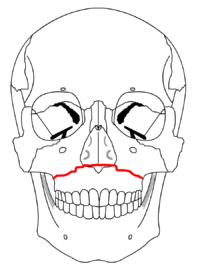Facial Trauma
Facial trauma, also known as maxillofacial trauma, refers to any physical injury to the face. This can involve soft tissue injuries like burns, lacerations, and bruises, or fractures of facial bones such as nasal fractures and fractures of the jaw.
Symptoms vary depending on the injury type but can include pain, swelling, loss of function, and changes in facial structure.

Signs and Symptoms

Fractures of facial bones are often accompanied by pain, bruising, and swelling. Nasal fractures may cause nosebleeds and deformity. Deformity in the face, such as a sunken cheekbone or misaligned teeth, also suggests fractures. Asymmetry in the face can indicate nerve damage. Mandibular fractures often result in pain, difficulty opening the mouth, and numbness in the lip and chin. Le Fort fractures may cause the midface to move relative to the rest of the skull.
Causes
Common causes of facial trauma include falls, assaults, sports injuries, and vehicle crashes. Blunt assaults, such as from fists or objects, are frequent causes. Facial trauma can also result from wartime injuries, animal attacks, and industrial accidents. In vehicle crashes, trauma typically occurs when the face strikes the vehicle's interior. Airbags can cause corneal abrasions and facial lacerations upon deployment.
Diagnosis

Radiography is used to rule out fractures, while angiography can locate bleeding sources. CT scanning is more definitive than X-rays for detecting fractures and examining soft tissues, though it is more expensive and harder to obtain. CT scans are especially useful in patients with multiple injuries.
Classification






Rene Le Fort classified facial fractures into three categories: Le Fort I, II, and III. Le Fort I involves the maxilla, Le Fort II includes the nasal bones and orbital rim, and Le Fort III involves the lacrimal bone, lamina papyracea, orbital floor, and ethmoid bone. These fractures are often associated with other serious injuries.

Common facial bones injured include the nasal bone, maxilla, mandible, zygoma, and frontal bone. The mandible can be fractured at several locations, including the symphysis, body, angle, ramus, and condyle.
Prevention
Preventative measures include laws enforcing seat belt use, public education on safety, and efforts to reduce drunk driving. Design improvements in automobiles can also help prevent facial injuries. Helmets and face guards in sports reduce the risk of severe facial injury. Correcting dental issues that increase the risk of dental trauma can also be beneficial.
Treatment


Ensuring an open airway is a primary treatment concern, as airway compromisation can be deadly. Material threatening the airway can be removed manually or using suction. Tracheal intubation may be difficult due to swelling, and nasal intubation may be contraindicated in the presence of facial trauma. A surgical airway may be necessary if other methods fail.

Dressings can keep wounds clean, and antibiotics may be used to prevent infection. Lacerations may require stitches, and severe bleeding must be controlled. Nasal packing can control nosebleeds, and fractures may be repaired with metal plates and screws. Bone grafting and wiring can also be used to repair fractures. Early repair generally results in better outcomes.
Prognosis and Complications

Facial trauma rarely threatens life directly but can be associated with dangerous injuries. Airway blockage due to bleeding or swelling is a significant risk. Facial injuries can cause disfigurement and disability, affecting eye, nose, or jaw function. Nerve and muscle entrapment by broken bones may require prompt realignment. Infection is a potential complication, especially from debris in wounds or bites.
Epidemiology
Facial trauma occurs in 50-70% of traffic accident survivors. Violence has become the leading cause in developed countries, while vehicle accidents remain prevalent in developing nations. Helmet use in motorcyclists reduces facial trauma risk. Facial fractures peak between ages 20-40, with children under 12 accounting for 5-10% of cases. Head and brain injuries often accompany facial trauma, particularly in the upper face.
Self-assessment MCQs (single best answer)
Which of the following bones is NOT commonly involved in facial trauma?
What is the main concern in the primary treatment of facial trauma?
Which diagnostic tool is more definitive for detecting fractures and examining soft tissues in facial trauma patients?
Le Fort II fractures include which of the following structures?
What is a common cause of facial trauma in vehicle crashes?
Which age group experiences the highest incidence of facial fractures?
Which classification of facial fractures involves the maxilla?
What is a significant risk associated with facial trauma?
Which preventive measure is NOT mentioned as a way to reduce facial trauma?
What type of injury is commonly associated with mandibular fractures?
Dentaljuce
Dentaljuce provides Enhanced Continuing Professional Development (CPD) with GDC-approved Certificates for dental professionals worldwide.
Founded in 2009 by the award-winning Masters team from the School of Dentistry at the University of Birmingham, Dentaljuce has established itself as the leading platform for online CPD.
With over 100 high-quality online courses available for a single annual membership fee, Dentaljuce offers comprehensive e-learning designed for busy dental professionals.
The courses cover a complete range of topics, from clinical skills to patient communication, and are suitable for dentists, nurses, hygienists, therapists, students, and practice managers.
Dentaljuce features Dr. Aiden, a dentally trained AI-powered personal tutor available 24/7 to assist with queries and provide guidance through complex topics, enhancing the learning experience.
Check out our range of courses, or sign up now!


